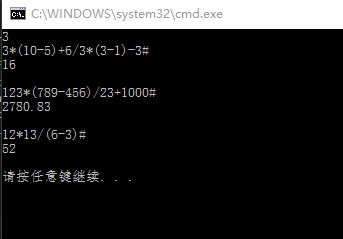为了实现用栈计算算数表达式的值,需设置两个工作栈:用于存储运算符的栈opter,以及用于存储操作数及中间结果的栈opval。
算法基本思想如下:
(1)首先将操作数栈opval设为空栈,而将'#'作为运算符栈opter的栈底元素,这样的目的是判断表达式是否求值完毕。
(2)依次读入表达式的每个字符,表达式须以'#'结尾,若是操作数则入栈opval,若是运算符,则将此运算符c与opter的栈顶元素top比较优先级后执行相应的操作,(具体操作如下:(i)若top的优先级小于c,即top<c,则将c直接入栈opter,并读入下一字符赋值给c;(ii)若top的优先级等于c,即top=c,则弹出opter的栈顶元素,并读入下一字符赋值给c,这一步目的是进行括号操作;(iii)若top优先级高于c,即top>c,则表明可以计算,此时弹出opval的栈顶两个元素,并且弹出opter栈顶的的运算符,计算后将结果放入占opval中。)直至opter的栈顶元素和当前读入的字符均为'#',此时求值结束。
算符间的优先关系如下表所示:
表中需要注意的是θ1为opter的栈顶元素,θ2位从表达式中读取的操作符,此优先级表可以用二维数组实现,具体见代码(表来源:严蔚敏《数据结构》)。
具体代码如下:
- #include<iostream> //输入的表达式要以'#'结尾,如‘5+6*3/(3-1)#’
- #include<cstring>
- #include<cstdio>
- #include<cctype>
- #include<stack>
- using namespace std;
- stack<char> opter; //运算符栈
- stack<double> opval; //操作数栈
- int getIndex(char theta) //获取theta所对应的索引
- {
- int index = 0;
- switch (theta)
- {
- case '+':
- index = 0;
- break;
- case '-':
- index = 1;
- break;
- case '*':
- index = 2;
- break;
- case '/':
- index = 3;
- break;
- case '(':
- index = 4;
- break;
- case ')':
- index = 5;
- break;
- case '#':
- index = 6;
- default:break;
- }
- return index;
- }
- char getPriority(char theta1, char theta2) //获取theta1与theta2之间的优先级
- {
- const char priority[][7] = //算符间的优先级关系
- {
- { '>','>','<','<','<','>','>' },
- { '>','>','<','<','<','>','>' },
- { '>','>','>','>','<','>','>' },
- { '>','>','>','>','<','>','>' },
- { '<','<','<','<','<','=','0' },
- { '>','>','>','>','0','>','>' },
- { '<','<','<','<','<','0','=' },
- };
- int index1 = getIndex(theta1);
- int index2 = getIndex(theta2);
- return priority[index1][index2];
- }
- double calculate(double b, char theta, double a) //计算b theta a
- {
- switch (theta)
- {
- case '+':
- return b + a;
- case '-':
- return b - a;
- case '*':
- return b * a;
- case '/':
- return b / a;
- default:
- break;
- }
- }
- double getAnswer() //表达式求值
- {
- opter.push('#'); //首先将'#'入栈opter
- int counter = 0; //添加变量counter表示有多少个数字相继入栈,实现多位数的四则运算
- char c = getchar();
- while (c != '#' || opter.top() != '#') //终止条件
- {
- if (isdigit(c)) //如果c在'0'~'9'之间
- {
- if (counter == 1) //counter==1表示上一字符也是数字,所以要合并,比如12*12,要算12,而不是单独的1和2
- {
- double t = opval.top();
- opval.pop();
- opval.push(t * 10 + (c - '0'));
- counter = 1;
- }
- else
- {
- opval.push(c - '0'); //将c对应的数值入栈opval
- counter++;
- }
- c = getchar();
- }
- else
- {
- counter = 0; //counter置零
- switch (getPriority(opter.top(), c)) //获取运算符栈opter栈顶元素与c之间的优先级,用'>','<','='表示
- {
- case '<': //<则将c入栈opter
- opter.push(c);
- c = getchar();
- break;
- case '=': //=将opter栈顶元素弹出,用于括号的处理
- opter.pop();
- c = getchar();
- break;
- case '>': //>则计算
- char theta = opter.top();
- opter.pop();
- double a = opval.top();
- opval.pop();
- double b = opval.top();
- opval.pop();
- opval.push(calculate(b, theta, a));
- }
- }
- }
- return opval.top(); //返回opval栈顶元素的值
- }
- int main()
- {
- //freopen("test.txt", "r", stdin);
- int t; // 需要计算的表达式的个数
- cin >> t;
- getchar();
- while (t--)
- {
- while (!opter.empty())opter.pop();
- while (!opval.empty())opval.pop();
- double ans = getAnswer();
- cout << ans << endl<< endl;
- getchar();
- }
- return 0;
- }
#include<iostream> //输入的表达式要以'#'结尾,如‘5+6*3/(3-1)#’
#include<cstring>
#include<cstdio>
#include<cctype>
#include<stack>
using namespace std;
stack<char> opter; //运算符栈
stack<double> opval; //操作数栈
int getIndex(char theta) //获取theta所对应的索引
{
int index = 0;
switch (theta)
{
case '+':
index = 0;
break;
case '-':
index = 1;
break;
case '*':
index = 2;
break;
case '/':
index = 3;
break;
case '(':
index = 4;
break;
case ')':
index = 5;
break;
case '#':
index = 6;
default:break;
}
return index;
}
char getPriority(char theta1, char theta2) //获取theta1与theta2之间的优先级
{
const char priority[][7] = //算符间的优先级关系
{
{ '>','>','<','<','<','>','>' },
{ '>','>','<','<','<','>','>' },
{ '>','>','>','>','<','>','>' },
{ '>','>','>','>','<','>','>' },
{ '<','<','<','<','<','=','0' },
{ '>','>','>','>','0','>','>' },
{ '<','<','<','<','<','0','=' },
};
int index1 = getIndex(theta1);
int index2 = getIndex(theta2);
return priority[index1][index2];
}
double calculate(double b, char theta, double a) //计算b theta a
{
switch (theta)
{
case '+':
return b + a;
case '-':
return b - a;
case '*':
return b * a;
case '/':
return b / a;
default:
break;
}
}
double getAnswer() //表达式求值
{
opter.push('#'); //首先将'#'入栈opter
int counter = 0; //添加变量counter表示有多少个数字相继入栈,实现多位数的四则运算
char c = getchar();
while (c != '#' || opter.top() != '#') //终止条件
{
if (isdigit(c)) //如果c在'0'~'9'之间
{
if (counter == 1) //counter==1表示上一字符也是数字,所以要合并,比如12*12,要算12,而不是单独的1和2
{
double t = opval.top();
opval.pop();
opval.push(t * 10 + (c - '0'));
counter = 1;
}
else
{
opval.push(c - '0'); //将c对应的数值入栈opval
counter++;
}
c = getchar();
}
else
{
counter = 0; //counter置零
switch (getPriority(opter.top(), c)) //获取运算符栈opter栈顶元素与c之间的优先级,用'>','<','='表示
{
case '<': //<则将c入栈opter
opter.push(c);
c = getchar();
break;
case '=': //=将opter栈顶元素弹出,用于括号的处理
opter.pop();
c = getchar();
break;
case '>': //>则计算
char theta = opter.top();
opter.pop();
double a = opval.top();
opval.pop();
double b = opval.top();
opval.pop();
opval.push(calculate(b, theta, a));
}
}
}
return opval.top(); //返回opval栈顶元素的值
}
int main()
{
//freopen("test.txt", "r", stdin);
int t; // 需要计算的表达式的个数
cin >> t;
getchar();
while (t--)
{
while (!opter.empty())opter.pop();
while (!opval.empty())opval.pop();
double ans = getAnswer();
cout << ans << endl<< endl;
getchar();
}
return 0;
}
结果:

